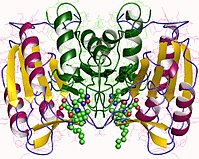
Photo from wikipedia
Imidazolidine and thiazolidine-based isatin derivatives (IST-01–04) were synthesized, characterized, and tested for their interactions with ds-DNA. Theoretical and experimental findings showed good compatibility and indicated compound–DNA binding by mixed mode… Click to show full abstract
Imidazolidine and thiazolidine-based isatin derivatives (IST-01–04) were synthesized, characterized, and tested for their interactions with ds-DNA. Theoretical and experimental findings showed good compatibility and indicated compound–DNA binding by mixed mode of interactions. The evaluated binding parameters, i.e., binding constant (Kb), free energy change (ΔG), and binding site sizes (n), inferred comparatively greater and more spontaneous binding interactions of IST-02 and then IST-04 with the DNA, among all compounds tested under physiological pH and temperature (7.4, 37 °C). The cytotoxic activity of all compounds was assessed against HeLa (cervical carcinoma), MCF-7 (breast carcinoma), and HuH-7 (liver carcinoma), as well as normal HEK-293 (human embryonic kidney) cell lines. Among all compounds, IST-02 and 04 were found to be cytotoxic against HuH-7 cell lines with percentage cell toxicity of 75% and 66%, respectively, at 500 ng/µL dosage. Moreover, HEK-293 cells exhibit tolerance to the increasing drug concentration, suggesting these two compounds are less cytotoxic against normal cell lines compared to cancer cell lines. Hence, both DNA binding and cytotoxicity studies proved imidazolidine (IST-02) and thiazolidine (IST-04)-based isatin derivatives as potent anticancer drug candidates among which imidazolidine (IST-02) is comparatively the more promising.
Journal Title: Molecules
Year Published: 2022
Link to full text (if available)
Share on Social Media: Sign Up to like & get
recommendations!